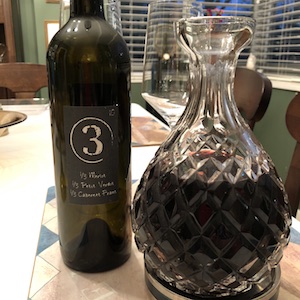 Time flies when you are having a blast with your best friend who also happens to be your spouse. That is the only way that I can describe the past three years with my best friend and husband, Paul. Well, to be completely honest, it has been 13 years since we have been friends and partners; however, three years ago we decided to marry on the exact date of our first date. That occurred on February 20, 2005 when a reluctant Paul agreed to a date with me to view art exhibits at the National Gallery of Art. Later that evening, we had charcuterie and cheeses with a bottle of red wine—-a Merlot from Gray Ghost Vineyards to be exact. This year is our third wedding anniversary and we thought it appropriate to celebrate with a Virginia red wine aptly named 3.
Time flies when you are having a blast with your best friend who also happens to be your spouse. That is the only way that I can describe the past three years with my best friend and husband, Paul. Well, to be completely honest, it has been 13 years since we have been friends and partners; however, three years ago we decided to marry on the exact date of our first date. That occurred on February 20, 2005 when a reluctant Paul agreed to a date with me to view art exhibits at the National Gallery of Art. Later that evening, we had charcuterie and cheeses with a bottle of red wine—-a Merlot from Gray Ghost Vineyards to be exact. This year is our third wedding anniversary and we thought it appropriate to celebrate with a Virginia red wine aptly named 3.
3 was a joint venture of three highly regarded Virginia wineries that included King Family Vineyards, Veritas Vineyards, and Grace Estate. The 2010 vintage was our last bottle of this joint effort. Virginia wine aficionados may remember that the 2010 growing season resembled Napa more so than Virginia. The summer was hot and dry, and drought was the word being bandied about by weathermen at the time. Virginia red wines from this vintage tend to be fuller bodied but higher in alcohol; in fact, we have opened very few Virginia red wines from the 2010 vintage. However, 3 struck us as appropriate for the occasion, and we were not disappointed with our decision to open it. I plopped an aerating device atop the bottle and then poured it into the decanter about an hour before dinner; we gave 3 a lot of time to breathe. Dinner included filet mignon served beside potatoes au gratin and roasted asparagus.
So what were our impressions? We poured 3 from the decanter into Bordeaux glasses (ok—-we were trying to be pretentious), and I noted aromas of blackberry, menthol and cedar. Generous blackberry jam greeted the palate with a bit of blueberry noted at mid-palate. A nice, lengthy finish complemented our meal. Our only regret was that this was the last bottle of 3 in our collection. Note to readers who still have 3 on the wine rack—-this is still aging well, so hang on to it for a bit longer if you wish.
We enjoyed celebrating three years of marriage with 3. It gave us the chance to visit memory lane to recall our time together. Virginia wines have always been a special part of our lives together. We hope that readers can recall similar special moments. Visit these three excellent wineries, and mention that Virginia Wine Time sent you.
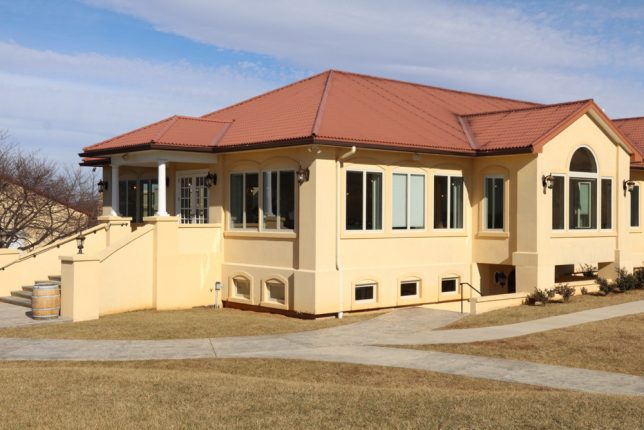
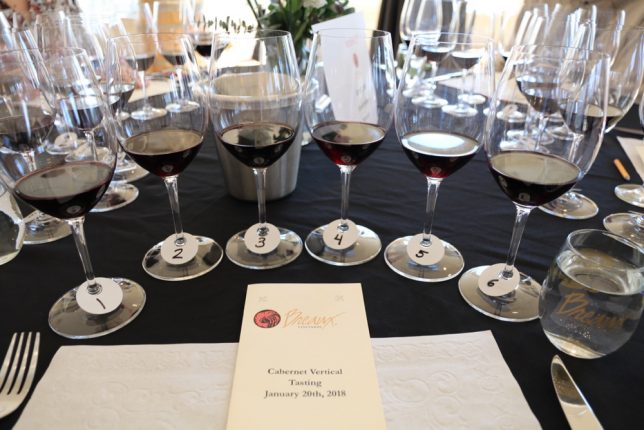
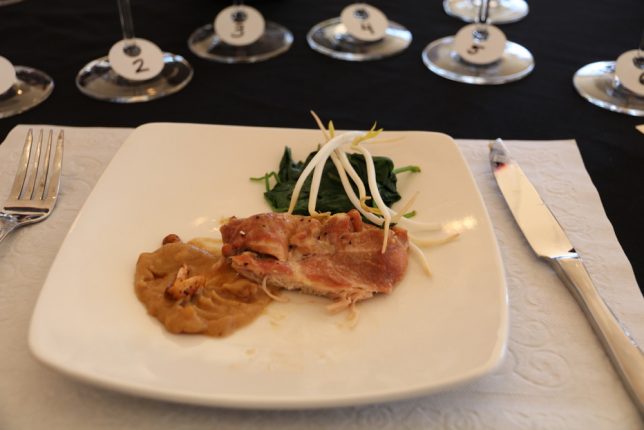
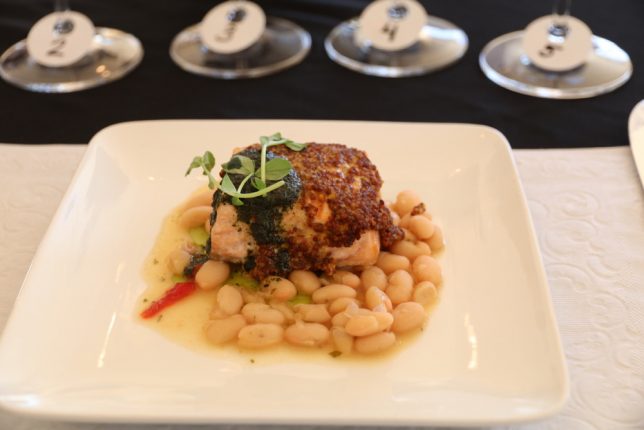
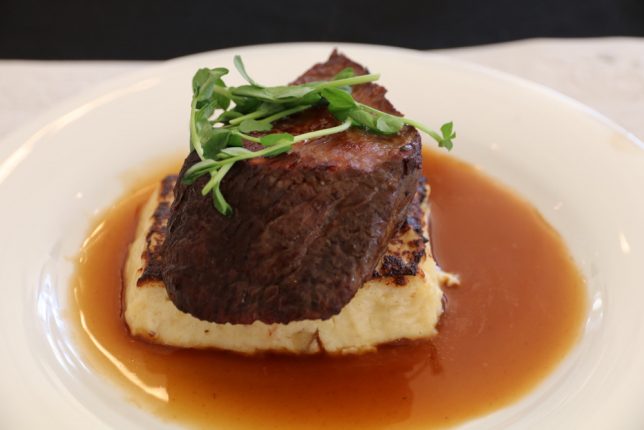
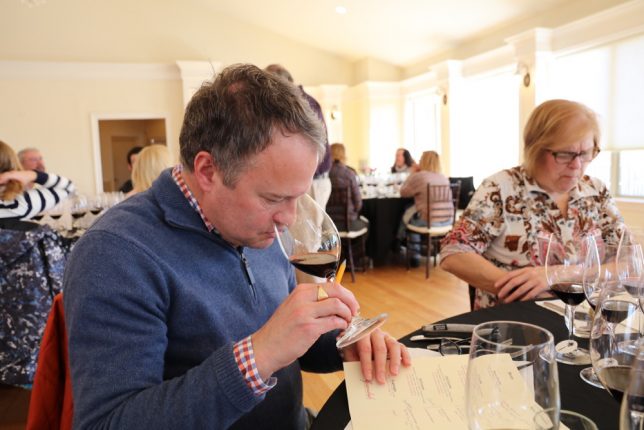
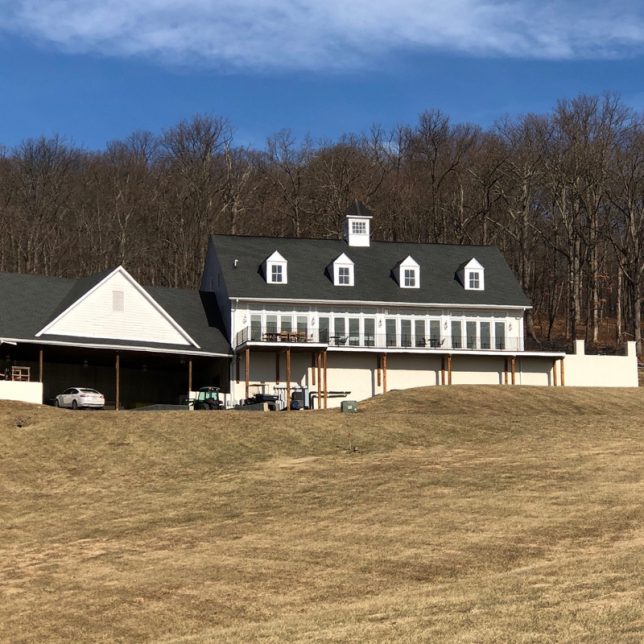
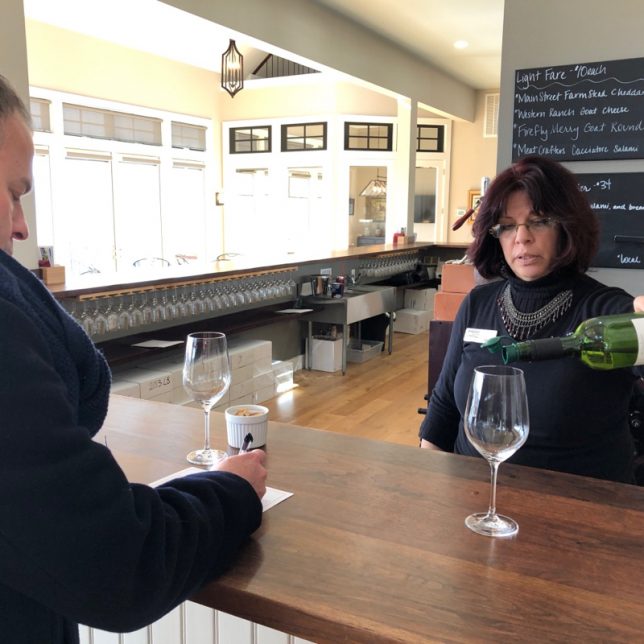
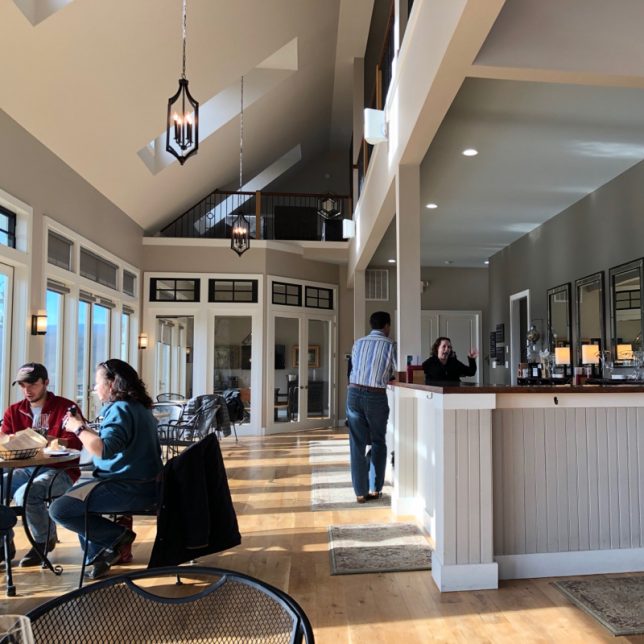
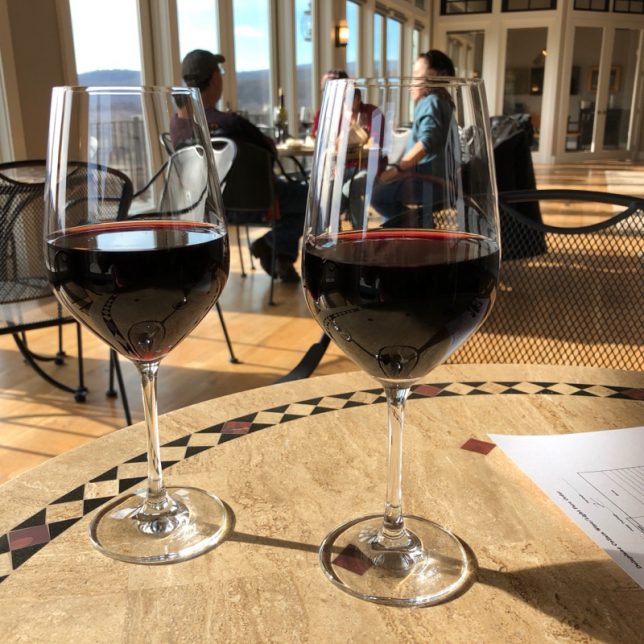
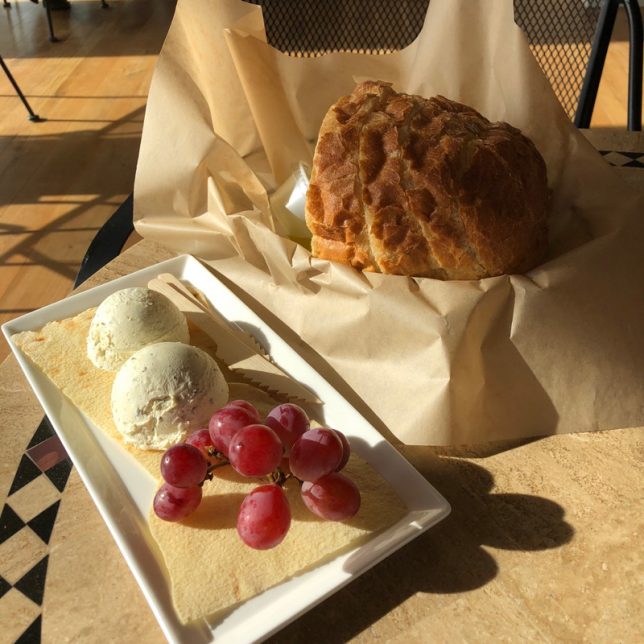
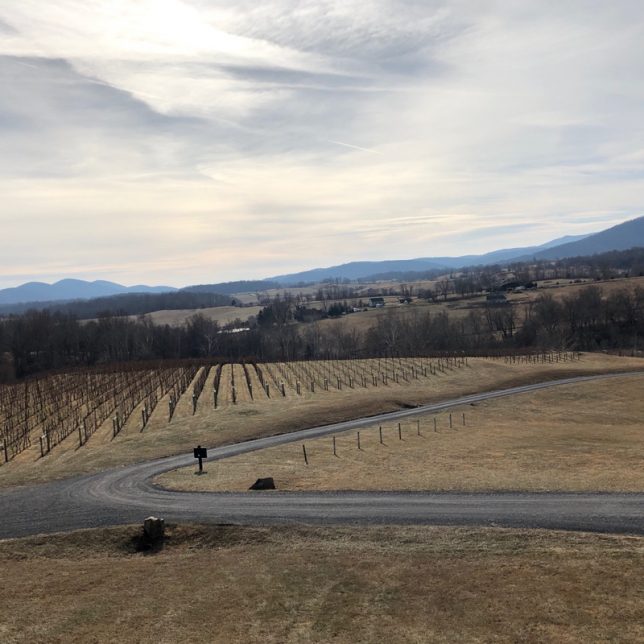
 2014 Mercer Canyons Cabernet Sauvignon: No surprise that if the Mercer whites reviewed in a previous post were the product of a hot growing season, then the reds developed in the same hot environment Aromas of smoke, candied cherries, ripe blackberries, and spice greeted the nose; similar flavors were observed in the mouth the an oak note on the finish. We found this Cabernet Sauvignon to be quite accessible; however, we opened at least 30 minutes before serving with strip steak and roasted potatoes.
2014 Mercer Canyons Cabernet Sauvignon: No surprise that if the Mercer whites reviewed in a previous post were the product of a hot growing season, then the reds developed in the same hot environment Aromas of smoke, candied cherries, ripe blackberries, and spice greeted the nose; similar flavors were observed in the mouth the an oak note on the finish. We found this Cabernet Sauvignon to be quite accessible; however, we opened at least 30 minutes before serving with strip steak and roasted potatoes. 2014 Mercer Canyons Red Blend: We enjoyed this one quite a bit and dubbed it a crowd pleaser. Merlot leads the blend (59%) that includes Syrah (16%), Grenache (10%), Sangiovese (6%), Petit Verdot (6%), and Viognier (2%). Smoky notes led on the nose followed by ripe red fruit and spicy aromas. The palate recalled mixed berry jam which lingered quite a while; dusty tannins provided structure. I enjoyed this one with lamb chops seasoned with rosemary and thyme. Feel free to keep this Red Blend on hand for summer fare done on the grill and lightly coated with barbecue sauce.
2014 Mercer Canyons Red Blend: We enjoyed this one quite a bit and dubbed it a crowd pleaser. Merlot leads the blend (59%) that includes Syrah (16%), Grenache (10%), Sangiovese (6%), Petit Verdot (6%), and Viognier (2%). Smoky notes led on the nose followed by ripe red fruit and spicy aromas. The palate recalled mixed berry jam which lingered quite a while; dusty tannins provided structure. I enjoyed this one with lamb chops seasoned with rosemary and thyme. Feel free to keep this Red Blend on hand for summer fare done on the grill and lightly coated with barbecue sauce. 2015 Sauvignon Blanc: This was produced from a very hot growing season, and initial notes trended toward tropical with a whiff of cut grass. A few swirls of the glass presented grapefruit aromas. Grapefruit flavors and a zesty finish made for a refreshing display on the palate. We enjoyed this Sauvignon Blanc with honey goat cheese and baguette. This is a nice wine for warm weather; enjoy on its own or paired with gamey cheeses, fresh fruit, or shellfish.
2015 Sauvignon Blanc: This was produced from a very hot growing season, and initial notes trended toward tropical with a whiff of cut grass. A few swirls of the glass presented grapefruit aromas. Grapefruit flavors and a zesty finish made for a refreshing display on the palate. We enjoyed this Sauvignon Blanc with honey goat cheese and baguette. This is a nice wine for warm weather; enjoy on its own or paired with gamey cheeses, fresh fruit, or shellfish. 2015 Chardonnay: Of course, this too was the product of a hot growing season. Chardonnay grapes in this bottling come from the best locations in the Horse Heavens Hills. I am not an ABCer (Anything But Chardonnay); in fact, I love Chardonnay. Needless to say, I looked forward to sampling this one. Pineapple and lime notes were complemented by juicy pear and apple flavors with oak nuances on the finish. I also savored the fuller mouth feel, and it was the perfect partner with roasted chicken served aside mashed potatoes.
2015 Chardonnay: Of course, this too was the product of a hot growing season. Chardonnay grapes in this bottling come from the best locations in the Horse Heavens Hills. I am not an ABCer (Anything But Chardonnay); in fact, I love Chardonnay. Needless to say, I looked forward to sampling this one. Pineapple and lime notes were complemented by juicy pear and apple flavors with oak nuances on the finish. I also savored the fuller mouth feel, and it was the perfect partner with roasted chicken served aside mashed potatoes.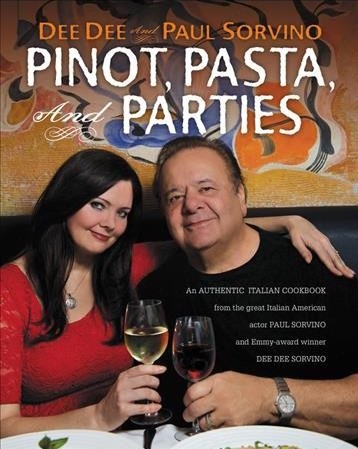 Renaissance man Paul Sorvino known for his role in Goodfellas but also a noted operatic tenor, sculptor and cook teams up with wife Dee Dee, herself an accomplished award winning television personality to produce Pinot, Pasta and Parties; this is a cookbook which presents Italian recipes with Paul’s personal flare. I am always on the lookout for well-organized cookbook that present easy-to-follow directions and suggested menus. This one certainly fits the bill, and I thought that I would share my thoughts for readers who want to consider this cookbook.
Renaissance man Paul Sorvino known for his role in Goodfellas but also a noted operatic tenor, sculptor and cook teams up with wife Dee Dee, herself an accomplished award winning television personality to produce Pinot, Pasta and Parties; this is a cookbook which presents Italian recipes with Paul’s personal flare. I am always on the lookout for well-organized cookbook that present easy-to-follow directions and suggested menus. This one certainly fits the bill, and I thought that I would share my thoughts for readers who want to consider this cookbook.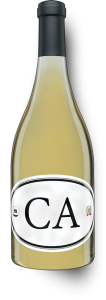 CA manages to meld both Old and New World styles. On both the nose and palate, it suggests the weight of a Napa inspired white wine; indeed, it is barrel aged in 30% new French oak in addition to fermentation in stainless steel tanks. Therefore, it presents a crisp entry with fruity flavors of pear, stone fruit and citrus. It finishes with a nutty element as well as a fuller mouth feel. Take time to note its lovely aromas of butterscotch, pear and lemon peel. In a way, it seemsto merge California and the Rhone region of France into a wine bottle. Who says white wines can’t be complex? CA is a blend of Chardonnay, Sauvignon Blanc, Viognier and Roussane; growers hale from Napa, Sonoma, and Mendocino. Food pairings? I enjoyed this one with roasted chicken with mashed potatoes. Herbed pork roast, dishes topped with cream sauce, goat cheeses on a toasted baguette—-you get the picture (or the menu ideas.)
CA manages to meld both Old and New World styles. On both the nose and palate, it suggests the weight of a Napa inspired white wine; indeed, it is barrel aged in 30% new French oak in addition to fermentation in stainless steel tanks. Therefore, it presents a crisp entry with fruity flavors of pear, stone fruit and citrus. It finishes with a nutty element as well as a fuller mouth feel. Take time to note its lovely aromas of butterscotch, pear and lemon peel. In a way, it seemsto merge California and the Rhone region of France into a wine bottle. Who says white wines can’t be complex? CA is a blend of Chardonnay, Sauvignon Blanc, Viognier and Roussane; growers hale from Napa, Sonoma, and Mendocino. Food pairings? I enjoyed this one with roasted chicken with mashed potatoes. Herbed pork roast, dishes topped with cream sauce, goat cheeses on a toasted baguette—-you get the picture (or the menu ideas.) Quite simply, we both adored this wine. On the nose, I noted aromas of spring blossoms, lime, orange zest, and shale; flavors of pear, lime and citrus zest led to a full and fruity palate followed by a crisp finish. Corse fully expresses a Mediterranean climate with its cool, breezy nights and warm, dry days. Did Napoleon Bonaparte, Corsica’s most famous native, enjoy this Vermentino with his favorite meal—-chicken and pasta with parmesan cheese? We hope so, and I thought of Napoleon when I prepared dinner. Crab cakes were on the menu, but I did toss some bowtie pasta with butter and parmesan cheese to serve as a side dish It proved to be a lovely pairing!
Quite simply, we both adored this wine. On the nose, I noted aromas of spring blossoms, lime, orange zest, and shale; flavors of pear, lime and citrus zest led to a full and fruity palate followed by a crisp finish. Corse fully expresses a Mediterranean climate with its cool, breezy nights and warm, dry days. Did Napoleon Bonaparte, Corsica’s most famous native, enjoy this Vermentino with his favorite meal—-chicken and pasta with parmesan cheese? We hope so, and I thought of Napoleon when I prepared dinner. Crab cakes were on the menu, but I did toss some bowtie pasta with butter and parmesan cheese to serve as a side dish It proved to be a lovely pairing! 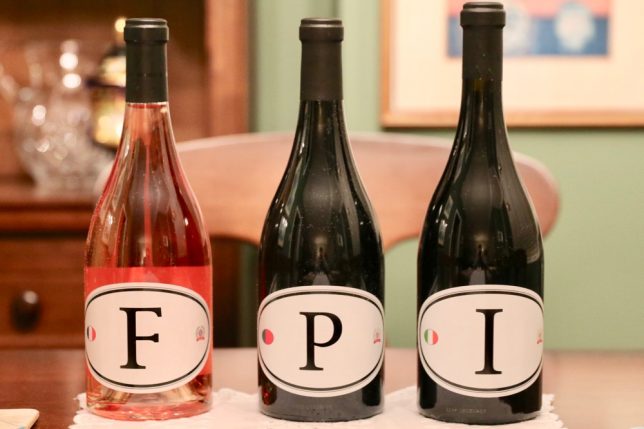
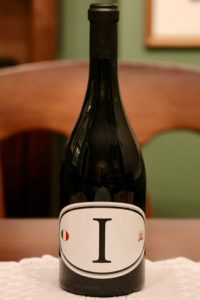 I is a blend of Negroamaro, Nero d’Avola, and Barbera, and these varietals represent fruit from Puglia located Southern region of Italy as well as Barbera located in the Piedmont region of Northern Italy. The result is a rich, complex wine with aromas of blackberry, charcuterie, fall spices and cedar. A fruity palate of dark berries gives way to spice and oak nuances. Enjoy with Italian fare or with beef dishes, a platter of sliced dried meats, and hard cheeses.
I is a blend of Negroamaro, Nero d’Avola, and Barbera, and these varietals represent fruit from Puglia located Southern region of Italy as well as Barbera located in the Piedmont region of Northern Italy. The result is a rich, complex wine with aromas of blackberry, charcuterie, fall spices and cedar. A fruity palate of dark berries gives way to spice and oak nuances. Enjoy with Italian fare or with beef dishes, a platter of sliced dried meats, and hard cheeses.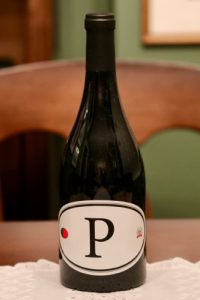 If roasted chops are on the menu, consider P, a blend of Portuguese grapes that includes Touriga Nacional, Trincadeira, and Touriga Franca. P also presents a fruity nose and palate with notes of plum, cherry and blackberry; hints of anise and black pepper also come out to play. We enjoyed P with roasted pork chops and roasted potatoes sprinkled with basil, thyme, and rosemary.
If roasted chops are on the menu, consider P, a blend of Portuguese grapes that includes Touriga Nacional, Trincadeira, and Touriga Franca. P also presents a fruity nose and palate with notes of plum, cherry and blackberry; hints of anise and black pepper also come out to play. We enjoyed P with roasted pork chops and roasted potatoes sprinkled with basil, thyme, and rosemary.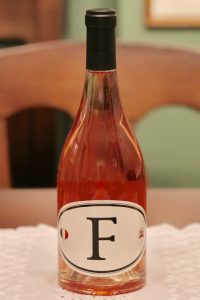 So what is F? Well, it follows the letter E; in addition, F is a rose produced from France. Hence, it earns the F designation on the label. F is produced from the Grenache grape grown in the vineyards of southern France. It presents a translucent pink tone in the glass that suggests summer but in reality is quite versatile all year round. We recently enjoyed it on a colder winter evening with pasta tossed with olive oil, thinly sliced ham, parmesan cheese, and Italian herbs. Floral notes were accompanied by aromas of strawberry and peach fuzz. Bright red berry and melon flavors played well with a flinty edge that made for a refreshing, dry rose. I love these kinds of roses in the summer, but I always make certain to have a stash of these on hand for Thanksgiving or any larger gathering where a variety of dishes may be served but different wine palates will have to be satisfied.
So what is F? Well, it follows the letter E; in addition, F is a rose produced from France. Hence, it earns the F designation on the label. F is produced from the Grenache grape grown in the vineyards of southern France. It presents a translucent pink tone in the glass that suggests summer but in reality is quite versatile all year round. We recently enjoyed it on a colder winter evening with pasta tossed with olive oil, thinly sliced ham, parmesan cheese, and Italian herbs. Floral notes were accompanied by aromas of strawberry and peach fuzz. Bright red berry and melon flavors played well with a flinty edge that made for a refreshing, dry rose. I love these kinds of roses in the summer, but I always make certain to have a stash of these on hand for Thanksgiving or any larger gathering where a variety of dishes may be served but different wine palates will have to be satisfied.